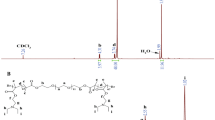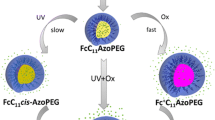Abstract
Purpose
To control drug release from block copolymer nanoassemblies by variation in the degree of photo-crosslinking and inclusion of acid sensitive linkers.
Methods
Poly(ethylene glycol)-poly(aspartate-hydrazide-cinnamate) (PEG-CNM) block copolymers were prepared and conjugated with a model drug, doxorubicin (DOX), through acid sensitive hydrazone linkers. The block copolymers formed photo-inducible, self-assembled nanoassemblies (piSNAs), which were used to produce photo-inducible crosslinked nanoassemblies (piCNAs) through UV crosslinking. The nanoassemblies were characterized to determine particle size, surface charge, pH- and crosslinking-dependent DOX release, in vitro cytotoxicity, and intracellular uptake as a function of photo-crosslinking degree.
Results
Nanoassemblies with varying photo-crosslinking degrees were successfully prepared while retaining particle size and surface charge. Photo-crosslinking caused no noticeable change in DOX release from the nanoassemblies at pH 7.4, but the DOX-loaded nanoassemblies modulated drug release as a function of crosslinking at pH 6.0. The nanoassemblies showed similar cytotoxicity regardless of crosslinking degrees, presumably due to the low cellular uptake and cell nucleus drug accumulation.
Conclusions
Photo-crosslinking is useful to control drug release from pH-sensitive block copolymer nanoassemblies as a function of crosslinking without altering the particle properties, and thus providing unique tools to investigate the pharmaceutical effects of drug release on cellular response.








Similar content being viewed by others
References
Imai K, Takaoka A. Comparing antibody and small-molecule therapies for cancer. Nat Rev Cancer. 2006;6:714–27.
Hennessy BT, Smith DL, Ram PT, Lu Y, Mills GB. Exploiting the PI3K/AKT pathways for cancer drug discovery. Cancer Rev Drug Discov. 2005;4:988–1004.
Kelland L. The resurgence of platinum-based cancer chemotherapy. Nat Rev Cancer. 2007;7:573–84.
Johnstone RW. Histone-deacetylase inhibitors: novel drugs for the treatment of cancer. Nat Rev Drug Discov. 2002;1:287–99.
Kawabata-Shoda E, Masuda S, Kimura H. Anticancer drug development from traditional cytotoxic to targeted therapies: evidence of shorter drug research and development time, and shorter drug lag in Japan. J Clin Pharm Ther. 2012;37(5):547–52.
Atkins JH, Gershell LJ. Selective anticancer drugs. Nat Rev Drug Discov. 2002;1(7):491–2.
Wood AJJ. Side effects of adjuvant treatment of breast cancer. New Engl J Med. 2001;344:1997–2008.
Johnstone RW, Ruefli AA, Lowe SW. Apoptosis: a link between cancer genetics and chemotherapy. Cell. 2002;108:153–64.
Brigger I, Dubernet C, Couvreur P. Nanoparticles in cancer therapy and diagnosis. Adv Drug Deliv Rev. 2012;64:24–36.
Brannon-Peppas L, Blanchette JO. Nanoparticle and targeted systems for cancer therapy. Adv Drug Deliv Rev. 2012;64(Supplement):206–12.
Peer D, Karp JM, Hong S, Farokhazad OC, Margalit R, Langer R. Nanocarriers as an emerging platform for cancer therapy. Nat Nanotechnol. 2007;2:751–60.
Davis ME, Chen Z, Shin DM. Nanoparticle therapeutics: an emerging treatment modality for cancer. Nat Rev Drug Discov. 2008;7:771–82.
Maeda H, Matsumura Y. EPR effect based drug design and clinical outlook for enhanced cancer chemotherapy. Adv Drug Deliv Rev. 2011;63(3):129–30.
Maeda H. Tumor-selective delivery of macromolecular drugs via the EPR effect: background and future prospects. Bioconjug Chem. 2010;21(5):797–802.
Mahon E, Salvati A, Baldelli Bombelli F, Lynch I, Dawson KA. Designing the nanoparticle-biomolecule interface for “targeting and therapeutic delivery”. J Control Release. 2012;161(2):164–74.
Petros RA, DeSimone JM. Strategies in the design of nanoparticles for therapeutic applications. Nat Rev Drug Discov. 2010;9(8):615–27.
Bourzac K. Nanotechnology: carrying drugs. Nature. 2012;491(7425):S58–60.
Yokoyama M. Polymeric micelles as a new drug carrier system and their required considerations for clinical trials. Expert Opin Drug Del. 2010;7(2):145–58.
Oerlemans C, Bult W, Bos M, Storm G, Nijsen JF, Hennink WE. Polymeric micelles in anticancer therapy: targeting, imaging and triggered release. Pharm Res. 2010;27(12):2569–89.
Vicent MJ, Ringsdorf H, Duncan R. Polymer therapeutics: clinical applications and challenges for development. Adv Drug Deliv Rev. 2009;61(13):1117–20.
Matsumura Y, Kataoka K. Preclinical and clinical studies of anticancer agent-incorporating polymer micelles. Cancer Sci. 2009;100(4):572–9.
Perrault SD, Walkey C, Jennings T, Fischer HC, Chan WCW. Mediating tumor targeting efficiency of nanoparticles through design. Nano Lett. 2009;9:1909–15.
Albanese A, Tang PS, Chan WCW. The effect of nanoparticle size, shape, and surface chemistry on biological systems. Annu Rev Biomed Eng. 2012;14:1–16.
He C, Hu Y, Yin L, Tang C, Yin C. Effects of particle size and surface charge on cellular uptake and biodistribution of polymeric nanoparticles. Biomaterials. 2010;31:3657–66.
Ruenraroengsak P, Cook JM, Florence AT. Nanosystem drug targeting: facing up to complex realities. J Control Release. 2010;141(3):265–76.
Kell DB, Dobson PD, Oliver SG. Pharmaceutical drug transport: the issues and the implications that it is essentially carrier-mediated only. Drug Discov Today. 2011;16(15–16):704–14.
Anraku Y, Kishimura A, Kobayashi A, Oba M, Kataoka K. Size-controlled long-circulating PICsome as a ruler to measure critical cut-off disposition size into normal and tumor tissues. Chem Commun. 2011;47(21):6054–6.
Stella VJ. Prodrugs: some thoughts and current issues. J Pharm Sci. 2010;99(12):4755–65.
Lee HJ, Bae Y. Pharmaceutical differences between block copolymer self-assembled and cross-linked nanoassemblies as carriers for tunable drug release. Pharm Res. 2013;30(2):478–88.
Lee HJ, Ponta A, Bae Y. Polymer nanoassemblies for cancer treatment and imaging. Ther Deliv. 2010;1(6):803–17.
Yallapu MM, Jaggi M, Chauhan S. Design and engineering of nanogels for cancer treatment. Drug Discov Today. 2011;16:457–63.
Shuai X, Merdan T, Schaper AK, Xi F, Kissel T. Core-cross-linked polymeric micelles as paclitaxel carriers. Bioconjug Chem. 2004;15:441–8.
Sun G, Hagooly A, Xu J, Nystrom AM, Li Z, Rossin R, et al. Facile, efficient approach to accomplish tunable chemistries and variable biodistributions for shell cross-linked nanoparticles. Biomacromolecules. 2008;9:1997–2006.
Lee HJ, Bae Y. Cross-linked nanoassemblies from poly(ethylene glycol)-poly(aspartate) block copolymers as stable supramolecular templates for particulate drug delivery. Biomacromolecules. 2011;12:2686–96.
Oberoi HS, Laquer FC, Marky LA, Kabanov AV, Bronich TK. Core cross-linked block ionomer micelles as pH-responsive carriers for cis-diamminedichloroplatinum(II). J Control Release. 2011;153(1):64–72.
Sahay G, Kim JO, Kabanov AV, Bronich TK. The exploitation of differential endocytic pathways in normal and tumor cells in the selective targeting of nanoparticulate chemotherapeutic agents. Biomaterials. 2010;31(5):923–33.
Kim JO, Sahay G, Kabanov AV, Bronich TK. Polymeric micelles with ionic cores containing biodegradable cross-links for delivery of chemotherapeutic agents. Biomacromolecules. 2010;11(4):919–26.
Bontha S, Kabanov AV, Bronich TK. Polymer micelles with cross-linked ionic cores for delivery of anticancer drugs. J Control Release. 2006;114(2):163–74.
Li Y, Hindi K, Watts Kristin M, Taylor Jane B, Zhang K, Li Z, et al. Shell crosslinked nanoparticles carrying silver antimicrobials as therapeutics. Chem Commun. 2010;46(1):121–3.
Van Horn BA, Wooley KL. Toward cross-linked degradable polyester materials: investigations into the compatibility and use of reductive amination chemistry for cross-linking. Macromolecules. 2007;40(5):1480–8.
O’Reilly RK, Joralemon MJ, Hawker CJ, Wooley KL. Facile syntheses of surface-functionalized micelles and shell cross-linked nanoparticles. J Polym Sci Part A Polym Chem. 2006;44(17):5203–17.
Cheng Z, Al Zaki A, Hui JZ, Muzykantov VR, Tsourkas A. Multifunctional nanoparticles: cost versus benefit of adding targeting and imaging capabilities. Science. 2012;338(6109):903–10.
Ali AH, Srinivasan KSV. Synthesis, characterization, and studies on the solid-state cross-linking of functionalized vinyl cinnamate polymers. J App Polym Sci. 1997;67:441–8.
Sung S-J, Cho K-Y, Hah H, Lee J, Shim H-K, Park J-K. Two different reaction mechanisms of cinnamate side groups attached to the various polymer backbones. Polymer. 2006;47:2314–21.
Bae Y, Fukushima S, Harada A, Kataoka K. Design of environment-sensitive supramulecular assemblies for intracellular drug delivery: polymeric micelles that are responsive to intracellular pH change. Angew Chem Int Ed. 2003;42:4640–3.
Bae Y, Jang W-D, Nishiyama N, Fukushima S, Kataoka K. Multifunctional polymeric micelles with folate-mediated cancer cell targeting and pH-triggered drug releasing properties for active intracellular drug delivery. Mol BioSyst. 2005;1(3):242–50.
Scott D, Rohr J, Bae Y. Nanoparticulate formulations of mithramycin analogs for enhanced cytotoxicity. Int J Nanomed. 2011;6:2757–67.
West KR, Otto S. Reversible covalent chemistry in drug delivery. Curr Drug Discov Technol. 2005;2(3):123–60.
Jones AT, Gumbleton M, Duncan R. Understanding endocytic pathways and intracellular trafficking: a prerequisite for effective design of advanced drug delivery systems. Adv Drug Deliv Rev. 2003;55(11):1353–7.
Bandak S, Ramu A, Barenholz Y, Gabizon A. Reduced UV-induced degradation of doxorubicin encapsulated in polyethyleneglycol-coated liposomes. Pharm Res. 1999;6:841–6.
Mizutani H, Tada-Oikawa S, Hiraku Y, Kojima M, Kawanishi S. Mechanism of apoptosis induced by doxorubicin through the generation of hydrogen peroxide. Life Sci. 2005;76:1439–53.
Acknowledgments and Disclosures
MD acknowledges the University of Kentucky Cancer Nanotechnology Training Center (UK-CNTC) postdoctoral traineeship, supported by the NCI/NIH and part of the National Cancer Institute Alliance for Nanotechnology in Cancer (5R25CA153954).
Author information
Authors and Affiliations
Corresponding author
Rights and permissions
About this article
Cite this article
Dickerson, M., Winquist, N. & Bae, Y. Photo-Inducible Crosslinked Nanoassemblies for pH-Controlled Drug Release. Pharm Res 31, 1254–1263 (2014). https://doi.org/10.1007/s11095-013-1246-6
Received:
Accepted:
Published:
Issue Date:
DOI: https://doi.org/10.1007/s11095-013-1246-6




